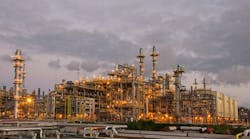Energy market concerns about price-driven demand destruction are “way overblown,” and oil demand has “held up remarkably well in the face of record oil prices” so far this year, said analysts in the Houston office of Raymond James & Associates Inc.
The US Energy Information Administration and Paris-based International Energy Agency blamed high fuel prices when each reduced its projection for oil demand growth in 2005 (OGJ Online, Oct. 13, 2005).
“Obviously, despite the inelastic nature of petroleum demand, we cannot escape the reality that $60 oil induces consumers to conserve energy usage, modestly curtails consumer spending (ex-energy), and encourages businesses to invest in more energy-saving technologies. However, we believe all this results in a healthy degree of demand management, which is needed to equilibrate the tight oil markets, as opposed to a collapse in demand,” Raymond James analysts said in an Oct. 31 report.
“The perceived oil demand destruction observed in October has been skewed by hurricane-driven softness [in the market] and distorted further by consumers’ drawing down secondary and tertiary inventories,” said Raymond James analysts. Despite the dictates of conventional wisdom that high oil prices should lead to sharply lower economic growth and reduce oil demand, industrial and transportation activity levels have remained solid.
“The industrialized economies appear better positioned to absorb high oil prices, and we do not believe $60 oil will kill the Golden Goose,” the analysts said. “Even if oil demand destruction does overshoot what is needed, we believe the downside in oil is limited. Specifically, we believe that [the Organization of Petroleum Exporting Countries] would step in, if necessary, by cutting production should oil prices fall back to the low $50s.”
Data revised
Meanwhile, the first revisions to August stocks of crude and petroleum products in the latest monthly report by the EIA showed gasoline demand grew more than four times as fast as weekly data had implied during that month, said Paul Horsnell of Barclays Capital Inc., London. “The level of US gasoline demand was revised upward by 97,000 b/d (1.1%) to 9.454 million b/d, which means that August just overtook July as having highest demand on record,” he said.
Horsnell reported Oct. 26 that retail prices for gasoline were “higher than current levels” in August with refinery operations disrupted by Hurricane Katrina in the final week of that month. “Given such prices, the demand profile might be expected to look rather weak if the demand destructionists are right,” he said.
Horsnell added, “It appears to us that the weekly data may have overestimated exports by about 300,000 b/d. That is enough in itself to account for more than half of the fall seen in the implied total oil demand estimate.”
Prices strengthen
Crude futures prices strengthened to above $61/bbl Oct. 27-28 in the New York market as oil companies reported record profits for the latest quarter. That prompted US Energy Sec. Sam Bodman to claim major integrated companies “have a responsibility to expand refining capacity” in his testimony before the Senate Energy Committee Oct. 27. Earlier that week, House Republican leaders urged oil companies to put some of their profits into expanding or building new refineries. Democrats introduced bills that would outlaw fuel price profiteering in times of crisis and would impose another windfall profits tax on the US oil industry.
The US Minerals Management Service reported 224 platforms and 6 drilling rigs in the Gulf of Mexico were still evacuated Oct. 28, with more than 1 million b/d of crude and 5.5 bcfd of natural gas shut in. That’s equivalent to 67.8% of daily crude production and 55% of daily natural gas production from federal leases in the gulf. Production lost since Aug. 26 totaled 71.6 million bbl of crude and 364.7 bcf of natural gas, respectively 13% and 9.99% of previous annual crude and gas production from those waters.
The Louisiana Office of Conservation said 912 MMcfd of natural gas production had resumed onshore and in state waters in 38 parishes. However, 45.5% of the wells in that region were reported shut in. The US Department of Energy said some 991,000 b/d of Gulf Coast refinery capacity remained shut down in the Gulf of Mexico on Oct. 28.
“The refining industry has been working around the clock to restore capacity affected by the recent hurricanes along the Gulf Coast,” said Bob Slaughter, president of the National Petrochemical & Refiners Association. “These efforts are part of our ongoing commitment to consumers. We believe that recent calls for more analysis of gasoline market trends will further substantiate this commitment.”
(Online Oct. 31, 2005; author’s e-mail: [email protected])

